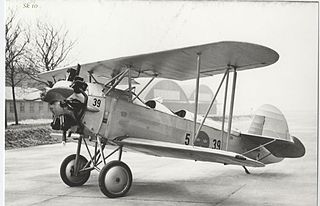
The Fokker D.XXI fighter was designed in 1935 by Dutch aircraft manufacturer Fokker in response to requirements laid out by the Royal Netherlands East Indies Army Air Force.

The VL Humu is a Finnish fighter aircraft, designed by Valtion lentokonetehdas in 1944, and based on the American Brewster F2A Buffalo.

VL Myrsky was a Finnish World War II fighter, designed by the State Aircraft Factory for the Finnish Air Force. The models of the aircraft were Myrsky I, Myrsky II, and Myrsky III.

VL Viima, constructed by the State Aircraft Factory is a Finnish two-seat, biplane trainer used by the Finnish Air Force from the late 1930s to the early 1960s. After military service, several were released into civil use.

VL Kotka ("Eagle") was a Finnish two-seat, biplane maritime patrol aircraft, designed and built by the Valtion lentokonetehdas or VL. It was meant as a cheaper replacement for the outdated IVL A.22 Hansas that were in service with the Finnish Air Force.

The Valmet Tuuli was a trainer aircraft, developed for the Finnish Air Force by the State Aircraft Factory. The aircraft was to be produced in 3 different versions. The last version, Tuuli III was redesigned from scratch, and is basically an entirely different aircraft.

Adaridi AD 3 was a wooden aircraft designed by the Russian engineer Boris Adaridin, who lived in Finland. It was a high wing aircraft with a low-powered engine. In 1923, the Finnish Air Force ordered one Adaridi aircraft. The aircraft was not given any official designation code. The maiden flight was on April 17, 1924.

Fokker D.X was a Dutch fighter aircraft designed after World War I.
The Friedrichshafen FF.41a was a large, German-built, three-seat, twin-engine floatplane reconnaissance aircraft designed by Flugzeugbau Friedrichshafen in 1917.

Friedrichshafen FF.49 was a German, two-seat, single-engine float-plane designed by Flugzeugbau Friedrichshafen in 1917.

Georges Levy G.L. 40 HB2 was a three-seated French, amphibious biplane aircraft that was designed in 1917. The aircraft was designed by Blanchard and Le Pen and therefore the aircraft was also known as the Levy-Le Pen. Le Pen was Maurice Jules-Marie Le Pen born in Lorient, Morbihan, France in 1889; he was killed in a car crash in 1919. It was claimed to be the best French amphibious aircraft of World War I, but that is probably due to the low scale production of such aircraft in France at that time.

IVL C.VI.25 was a Finnish fighter aircraft designed by IVL. It was a further development of the IVL C.24.

IVL K.1 Kurki was a prototype for a four-seated, high-wing trainer aircraft, which was designed in 1927 by IVL. The designer was Asser Järvinen and the prototype was manufactured at the IVL plant at Suomenlinna. The aircraft made its maiden flight on March 30, 1927. Only one aircraft was manufactured.

The LVG C.VI was a German two-seat reconnaissance and artillery spotting aircraft used during World War I.

Grigorovich M-9 was a Russian World War I-era biplane flying boat, developed from the M-5 by Grigorovich.
Grigorovich M-16 was a successful Russian World War I-era biplane flying boat of the Farman type, developed from the M-9 by Grigorovich. Somewhat larger than the M-9, the M-16 was a version especially intended for winter operations, with better aerodynamic qualities.

Raab-Katzenstein RK-26 Tigerschwalbe, also known as the Fieseler F 1 Tigerschwalbe, was a German twin-seat biplane trainer aircraft designed by Gerhard Fieseler by the end of the 1920s.
Kurt Volmar Berger (1896–1977) was an aviation engineer and the chief designer at the Finnish aircraft manufacturing company Valtion Lentokonetehtaat.

Hansa-Brandenburg W.33 was a German two-seat, low-wing single-engined seaplane, which had been designed by Hansa und Brandenburgische Flugzeugwerke during World War I. Although the W.33 was built in relatively small numbers, the design was widely recognized as successful and numerous copies and license built versions were built by the hundreds after World War I.
The Friedrichshafen FF.71 was a German biplane floatplane of the 1910s produced by Flugzeugbau Friedrichshafen.
















